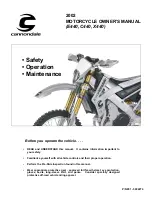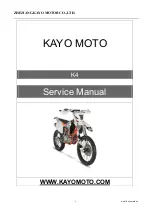
L.6
TE 250R - 310R 2013 I.E. / TE 310R 2013 I.E. USA
TC 250R 2013 - TC 250R 2013 I.E. USA
TXC 250R - 310R 2013 I.E. USA
BRAKES
Workshop Manual Ed. 07-2012
Bleeding the front braking system
A long travel and mushy feel of the brake lever indicate that there is air in the
system and the brake needs bleeding.
Bleeding procedure is as follows:
- Take the rubber cap off the bleed valve (1).
- Attach a clear plastic hose to the calliper bleed valve and place the other
end of the hose in a vessel (make sure the hose end stays dipped in the fluid
throughout the procedure).
- Remove the reservoir plug (2) and the rubber gaiter and fill fresh fluid into
the reservoir.
- Pull the lever (3) of the brake and keep it pulled so that the system remains
under pressure, loosen the valve (1), tighten the valve (1) always with the
lever pulled, then release the lever.
- Top up the fluid level, wait a few seconds, then repeat a few times the proce
-
dure described in the line above until the liquid comes out of the transparent
hose without bubbles.
- Tighten the bleed valve to the indicated torque, restore the fluid level (A) and
refit the rubber gaiter and cover (2) of the tank.
Fluid level inside the reservoir shall never drop below the minimum
notch during the bleeding procedure.
Brake fluid is corrosive. In the event of contact with eyes, rinse with
abundant water.
Motorcycle handlebar must be turned to the left during the bleed-
ing procedure. This will keep the master cylinder reservoir higher,
making bleeding easier.
The bleeding procedure does not remove all air from the circuit; any
small amounts of air left in the circuit will disappear after a short
period of usage; this will eliminate the mushy feel of the lever and
restore its travel to proper length.
If brake lever or brake pedal feel mush after a fall or a repair result-
ing in loss of braking, bleed the circuit as described above.
Bleed valve tightening torque: 12-16 Nm, 1.2-1.6 Kgm, 8.8-11.8 ft/lb.
















































